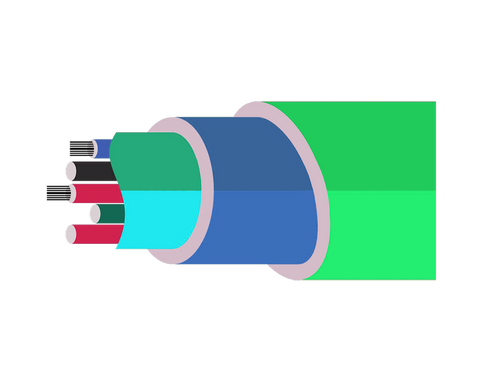Hybrid Fiber Coax (HFC) Cables for Multi-System Operators (MSO)
May 05, 2016

HFC is used by multi-system operators (MSO) and cable operators as a service delivery architecture. It uses coaxial and fiber optic cabling to distribute voice content, data and video to and from the headend and subscribers. Signals are typically sent from the headend via a hub to within a mile of the final destination using a fiber optic cable. For a service area that ranges from 64 homes to 1,000 subscribers, the fiber optic cable is terminated in an HFC node. Optical signals are then converted to radio frequency (RF) signals and transmitted via coaxial cable to subscriber's businesses or homes.
The size of the service area that can be handled is determined by the amount of bandwidth subscribers consumes. As each HFC node is connected directly back to the headend, more data can be delivered per subscriber from the headend for smaller service areas.
The coaxial cable used at the subscriber is a small, flexible cable that can be connected directly to the set-top box, cable modem, or other equipment. The RF signal on this cable is strong enough so that signals can be split within the premises. If there are many separate devices at the premises, amplification may be needed. This is normally done with a house amp or drop amp. Amplifier and splitters may be pooled to decrease the number of connections.
Frequency division multiplexing is used in HFC networks to package content into a cable plant’s spectrum slots. In this case, spectrum is the frequency bands that are used for the content. In USA, this is 5 to 42 MHz for subscriber to headend (reverse) and 52 to 1004 MHz for headend to subscriber (forward). Split frequencies and spectrum allocations do however differ internationally.
Signals that start in the headend and need to be sent to subscribers can be analog or digital. In the latter case, the signal is modulated with quadrature amplitude modulation (QAM). These signals are produced by using digital representations of the original signal, be it a video or analog voice signal, and then converting it through sampling and modulation of a carrier. The resultant signal is an analog signal with high-capacity. It should be noted that this signal needs to maintain a high signal-to-noise ratio (SNR). In contrast, a digital optical signal used in GPON or GEPON (gigabit passive optical networks), has much simpler SNR requirements.
CableLabs, a non-profit R&D organization funded by industry, manages the standard governing the QAM transport. This standard is known as Data Over Cable Service Interface Specification (DOCSIS). DOCSIS 3.0 is deployed the most widely. DOCSIS 3.1, the latest version, improves the data throughput to subscribers and modulation rates significantly, while at the same time expands the upstream to 85 MHz and more and the downstream to 1200 MHz and more.
Share this post
6 comments


How does your writing team keep up with all the latest developments in cell phone technology including booster systems, accessories, and related items like cables? I could see if you focused on one area such as signal boosters, but signalbooster.com covers a huge amount of topics. It also seems to cover them well. The explanations are usually easy to understand and while this site is here to sell things, it’s very informative, regardless of whether you are buying anything. This article on hybrid fiber coax cables is just another example.
What causes dropped calls, Lewis? Your cell phone operates on the principle of a cell phone tower sending signals to your phone, allowing you to make calls. Think of this signal as an invisible cord. As long as the cord is connected, you’ll be able to call, just as you do with a traditional landline phone. However, if your phone is too far away from a cell tower (perhaps you’re far out in a rural area) or more likely, something interferes with the signal (such as a structure and/or building materials), the invisible cord is cut and you lose your call. That’s why people get cell phone boosters for their homes and motor vehicles to boost the signal so the invisible cord doesn’t get cut.
It’s interesting how cables are similar for different things such as HDTV and cell phones. I know these things are used to boost cell phone signals, but I’m curious as to what causes dropped cell phone calls?
I’ve heard big buildings have special requirements for your cell phone needs. There are a number of factors that can reduce or block cell phone signals. These include building materials and even the way the building is structured. That’s why some places need a DAS installation to make sure all areas receive the maximum cell phone power. Hybrid fiber coax cables sound like a good way to maximize this.
Are coaxial cables being used much for home cable? I thought fiber optic had replaced cable, much as cell phones are replacing landlines (maybe that’s not the best analogy). Speaking of which, I’m looking to boost my cell phone’s power so I have the assurance of being able to make calls without having a dropped call or bad call clarity. Are cell phone boosters a good option, especially for someone who plans to use a cell phone as their home phone?
Hybrid Fiber Coax Cables sound like a powerful means of amplifying multi-service operators’ delivery system. I didn’t know signals could be sent via analog or digital (I assumed everything was digital now). I read elsewhere on a DAS installation blog that there are ways to maximize cable effectiveness in DAS installs. Is that so for HFC cables too?